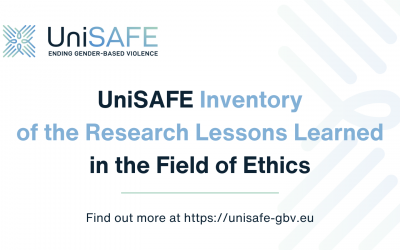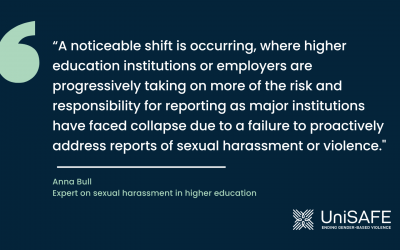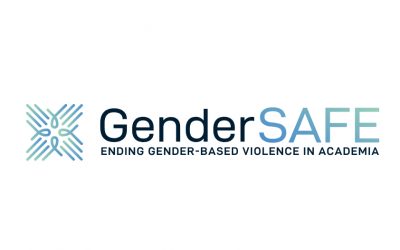From policy to practice:
The evidence base for ending gender-based violence in higher education and research
UniSAFE has released its second White Paper intended for institutional leadership, change agents and responsible staff in higher education institutions and research organisations. Building on the project’s state-of-the-art insights on gender-based violence in higher education and research, the white paper is a distillation of critical issues that should be addressed when designing, implementing, monitoring and evaluating institutional policies.
Nearly 62% of the over 42,000 respondents who took part in UniSAFE’s survey on gender-based violence in academia and higher education (2022) disclosed having experienced at least one form of gender-based violence, including incidents of physical, sexual violence and harassment, psychological, economic and online violence, in their place of work or study. Among respondents, 66% of women, 56% of men and 74% of non-binary respondents disclosed experiences of at least one form of gender-based violence. Non-binary, trans and LGBQ+ students and staff, as well as students and staff from ethnic minorities, and students/staff with a disability or a chronic illness were affected more often. In contrast to these numbers, only 7% of students and 23% of staff who experienced gender-based violence in the context of their institution reported the incident. The research in the UniSAFE project shows that survivors did not report incidents because they were not sure that the behaviour was serious enough to report, they did not recognise the behaviour as violence at the time of the incident or did not think that anything would happen if they reported the incident (Lipinsky et al. 2022).
These findings underscore the high prevalence of gender-based violence, and they hint at the permissiveness of violence in organisational cultures and the failure of institutions to define and address unacceptable behaviours in higher education and research organisations. As supported by other studies conducted as part of the project, they also reveal the continued lack of effective policies, their poor design and the failure to implement them when adopted (Huck et al. 2022; Blazyte and Pilinkaite Sotirovic 2022; Linková et al. 2023; Ranea-Triviño et al. 2022).
About the white paper
The aim of this white paper is to draw attention to the roles and responsibilities of higher education and research organisations in addressing gender-based violence. These roles and responsibilities may not be recognised or are downplayed, and this results in institutions failing to take appropriate action to ensure safe environments for students and staff. Secondly, the white paper aims to explicate the essential features and elements of effective policies and actions and lastly, to highlight the critical role of institutional leadership in making the policy frameworks and actions work.
The white paper first defines gender-based violence and its specificities in the sectors of higher education and research. It then addresses the consequences of gender-based violence and goes on to identify the roles and responsibilities of higher education and research organisations in ending gender-based violence. The document then continues with the definition of the main components of institutional policies and their implementation, including evidence related to the consequences of gender-based violence and the roles and responsibilities of institutions. These institutional responsibilities are addressed in relation to the needs of the victims/survivors, the needs of the responsible staff, in terms of the policy design and implementation and in terms of the policy content according to the 7P model theorised in UniSAFE (Mergaert et al. 2023). The paper concludes by first recognising the pivotal role that leadership plays in ensuring the success of institutional policies that help victims and survivors and prevent gender-based violence in organisational settings and finally, by emphasising the need to move to a proactive approach when creating safe working and study environments.



